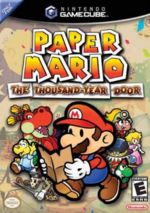Paper Mario: The Thousand-Year Door

| |
| Paper Mario: The Thousand-Year Door | |
| Developer | Intelligent Systems |
| Publisher | Nintendo |
| System | Nintendo Gamecube |
| Release Date | JP July 22, 2004 US October 11, 2004 EU November 12, 2004 |
| Gallery | GH Gallery |
| Rating | ESRB: E |
Paper Mario: The Thousand-Year Door (known in Japan as simply Paper Mario RPG) is an RPG game which acts as a sequel to the original Paper Mario. It was released for the Nintendo Gamecube in 2004.
Story[edit]
On vacation in Rogueport, Princess Peach is given a chest that can only be opened by the pure of heart by a merchant. Peach is able to open it and finds a map inside. She sends it to Mario, but she goes missing soon afterwards, at which point Mario hurries to try to find her.
When Mario arrives at Rogueport, he sees a young Goomba being harassed. After saving her, she tells him that she's a student of archeology. They show the map to her professor who tells them that it shows the location of the seven crystal stars. Mario decides to search for the stars in hopes of finding Peach on the way, and he ends up facing a new group of enemies in the process.
Gameplay[edit]
The core gameplay is retained from the previous Paper Mario, but it does receive an expansion in the fomr of an audience that watches the battles. They can sometimes throw items on stage and determine how quickly the player's Star Power recharges.
This installment also gives Mario the ability to transform into other paper-based forms within the overworld, such as a paper airplane. These abilities are learned at several different points in the game.
Much like the previous game, this one is divided into chapters and also features interludes in which the player controls Princess Peach. This game also adds segments where Bowser is playable in a side-scrolling style.
Legacy[edit]
Sequels[edit]
It was followed by Super Paper Mario for the Nintendo Wii, which took on a new gameplay style.